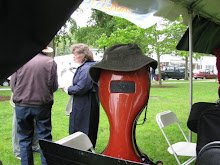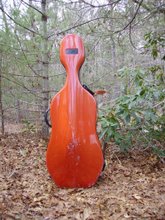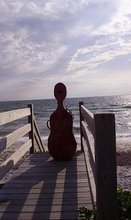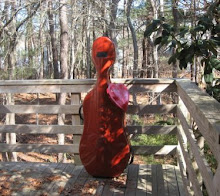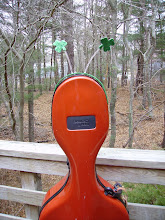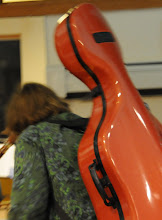Though it seems as though May began only yesterday, it is coming to an end and June is about to burst out all over. A progress report seems in order.
I had an ambitious plan for May and June cello practicing and performance and started out in a frenzy (for me) of practicing. Everything, every day. For one reason or another, I missed a couple of cello lessons and a few practice sessions.
I started to concentrate on the first performance, the fiddle group performance on June 13. I am making progress on that. I have the four tunes mostly memorized, but there are still a few spots where I hesitate, there are a few intonation issues, and there is one tune that is just going by awfully fast.
Yesterday, at rehearsal, I used sheet music because I did not feel secure without it (I tried not to look at it), and the others (who do not use sheet music) said it would be fine, if I used it during the performance. I have two more weeks, though, and am really going to try to get to the point where I am ok without it.
The fiddlers were more complimentary about my playing than my intonation called for, and, when we were listening to a tape of our session, and I was thinking, gosh, I need to play softer, one of the fiddlers said, "we need to mike the cello." I don't think this is in our best interests.
I am playing with the adult piano students on June 12, and have a rehearsal with them this week. The music is easy (including the Berceuse from Suzuki, book 3), so I am just working on making it sound expressive and musical.
I have not done much on the cello duets or Marcello in the last two weeks (very busy work weeks for me), but for a time there I was feeling competent.
The Haydn trios are coming along for the June 20 performance. Still a couple of fast parts to bring up to speed.
Tomorrow, I plan to attend a performance of a string orchestra that I am considering joining for the summer. It starts June 8, and runs for 10 weeks, which is a little more of a commitment than I wanted to make this summer. But, the conductor is an excellent cellist, and I might learn a lot (if I practice).
Sunday, May 31, 2009
Sunday, May 10, 2009
The Plan for May and June
After our orchestra concert the first week in April, I focused on non-cello things for a few weeks, maybe a month, and though I continued weekly lessons, there were some weeks when I didn't practice at all between lessons. One of those times. But my cello teacher was understanding, supportive, and encouraging.
I think I am mostly back on track now, or at least edging toward it. I have several performances coming up in June, so really need to buckle down and find time to practice every day. Well, most days.
The first event is a fiddle performance in mid-June. The group I play with (women fiddlers) is performing four waltzes, and I have written harmony (second) parts to three of them, to accompany the fiddles. The music is easy enough, but it has to be played from memory, which tends to take time, and it will be tricky playing the harmony, with everyone else playing melody. I will have to focus! This is in mid-June.
The following weekend, I am playing with three groups during the arts festival: the larger fiddle group, the flute choir, and a flute, string, and keyboard group.
The larger fiddle group plays many tunes that I still do not have memorized, but I can usually play some sort of improvised pizzicato accompaniment.
In the other groups, we can use sheet music, and I am grateful for that!
The flute choir is playing trio 1 and 4 of the Haydn London Trios and Vivaldi's Goldfinch concerto (plus others in which I play flute), and we have not yet determined the program for the string group, but it may be a piece by Marais, Purcell (Golden Sonata), and/or flute sonatas by Marcello, in which I play the continuo. I have also played these on flute and enjoy them, particularly the first one, which I played recently (on flute) at church. In another context a flute-playing friend of mine remarked that she had played them when she was 10 years old. Ah, well.
In addition to that, I am working on a DeFesch sonata with another cellist, and, because it and the Marcello flute sonatas, reminded me of the Marcello piece in Suzuki book 4, I decided to go back and learn/polish that too. (I abandoned Suzuki about a year ago, to work on other things.)
Then, for intonation and related issues, I am working in the Piatti cello method. My teacher mentioned trying another duet with another of her students, and there is always something that looks interesting, so I am sure the list will grow.
But I am trying to focus.
I think I am mostly back on track now, or at least edging toward it. I have several performances coming up in June, so really need to buckle down and find time to practice every day. Well, most days.
The first event is a fiddle performance in mid-June. The group I play with (women fiddlers) is performing four waltzes, and I have written harmony (second) parts to three of them, to accompany the fiddles. The music is easy enough, but it has to be played from memory, which tends to take time, and it will be tricky playing the harmony, with everyone else playing melody. I will have to focus! This is in mid-June.
The following weekend, I am playing with three groups during the arts festival: the larger fiddle group, the flute choir, and a flute, string, and keyboard group.
The larger fiddle group plays many tunes that I still do not have memorized, but I can usually play some sort of improvised pizzicato accompaniment.
In the other groups, we can use sheet music, and I am grateful for that!
The flute choir is playing trio 1 and 4 of the Haydn London Trios and Vivaldi's Goldfinch concerto (plus others in which I play flute), and we have not yet determined the program for the string group, but it may be a piece by Marais, Purcell (Golden Sonata), and/or flute sonatas by Marcello, in which I play the continuo. I have also played these on flute and enjoy them, particularly the first one, which I played recently (on flute) at church. In another context a flute-playing friend of mine remarked that she had played them when she was 10 years old. Ah, well.
In addition to that, I am working on a DeFesch sonata with another cellist, and, because it and the Marcello flute sonatas, reminded me of the Marcello piece in Suzuki book 4, I decided to go back and learn/polish that too. (I abandoned Suzuki about a year ago, to work on other things.)
Then, for intonation and related issues, I am working in the Piatti cello method. My teacher mentioned trying another duet with another of her students, and there is always something that looks interesting, so I am sure the list will grow.
But I am trying to focus.
Friday, May 8, 2009
The Soloist, review
I wrote this review of "The Soloist" for the Falmouth Enterprise, which no longer publishes articles online. I could have written my own book about "The Soloist," but compressed it here.
Because I read the book first (and because my sister graduated from Juilliard), I was interested in how accurately the movie represented the book. (There is also the question of how accurately the book represented the true story, but I can't answer that).
I searched the web for reactions from musicians, mental health people (those with schizophrenia and those expert in schizophrenia), homeless people and experts, and newspaper columnists, for other views, but found very little. The book/movie raises many interesting discussions about music, mental health, homelessness, and the current state of the newspaper industry, so I do think it worthy of discussion.
‘The Soloist,’ In Praise Of Friendship, Music
“The Soloist” is the mostly true story of the real-life relationship between Los Angeles Times columnist Steve Lopez (Robert Downey Jr.) and Nathaniel Anthony Ayers (Jamie Foxx), a homeless, schizophrenic musician whom he befriends, initially for a story, and, ultimately, because he cares about him and values his friendship. Mr. Ayers, in turn, accepts Mr. Lopez’s friendship and is transformed by it, as both are transformed by the healing power of music.
It deals not only with mental illness, homelessness, and music, but also with the financially crumbling newspaper industry, urban politics, work and family issues, and the attack of aggressive raccoons. I thought the latter had been thrown in for comic effect, but in fact, Mr. Lopez has also written columns about these mangy creatures, so there was some logic to this otherwise irrelevant subtheme.
Steve Lopez knows a story when he sees one, and did some research, discovering that Nathaniel had once been a promising scholarship student at Juilliard, but had to drop out when the pressure became too much for him and he had a nervous breakdown. His bad experiences with multiple forms of therapy led him to a homeless existence, practicing in noisy traffic tunnels, or in a downtown park, under a statue of Beethoven, and sleeping on the streets at night, scaring off rats with sticks.
His series of columns on Nathaniel convince the mayor to prioritize homeless-assistance programs (there are 90,000 homeless people in Los Angeles). More importantly (to the plot of the movie), the reporter strives to get Nathaniel off the street for his own safety, partly to continue to have something to write about, but also, increasingly, because of his growing friendship and respect for him.
Both Foxx and Downey are excellent in this movie. Foxx is particularly convincing as Ayers, in part because he is an excellent actor, a fine musician, and spent hours observing the real Nathaniel Ayers to better capture his vulnerability, anger, confusion, and his passion for music.
But Foxx also had a personal connection with the role. According to The Los Angeles Times, when he was 18, and in music school himself, someone slipped a psychotropic drug in his drink, and he came close to losing his mind. Flashbacks continued for almost a year, and he spent hours and hours playing the piano in an effort to escape, an experience very similar to Mr. Ayers’s, but without the devastating lasting impacts. He did have panic attacks and bouts of paranoia during the filming of “The Soloist,” though, fearing his own madness could return.
“The Soloist” was directed by Joe Wright, who also directed “Atonement,” a movie that I thought was better than the book. This was not the case with the “Soloist.” I might have enjoyed “The Soloist” more, if I had not read the book first.
Mr. Lopez’s book, whose full title is “The Soloist: A Lost Dream, An Unlikely Friendship, and the Redemptive Power of Music,” tells a slightly different story, and the arbitrary changing of, for the most part, minor details in the story was unnecessary and sometimes annoying.
In the movie, Nathaniel Ayers is a cellist at Juilliard, and, when a kindly arthritic woman gives him the valuable cello that she has played for 50 years, he plays magnificent, ethereal music on it without the use of vibrato and without stopping to tune it. He fills the tunnel, and all of Los Angeles, with exquisite, uplifting music.
In the book, he was a string bass player at Juilliard, and taught himself cello and violin later. Though he is clearly uniquely gifted, the book makes it clear that his playing, like his personality, is a bit disconnected and rough around the edges. He forgets notes; he adds unwritten flourishes, playing the way he talks, sometimes making sense, sometimes off on poetic or incomprehensible tangents. In the book, the donated cello is a student cello provided by a businessman, and Nathaniel sometimes tunes it endlessly, as a nervous activity. And he overuses vibrato, rather than avoiding it.
These are many more examples, including changes in Mr. Lopez’s life. Sometimes these detract from the movie, making it seem that the only mentally ill people worth caring about are those with extraordinary talent.
In a recent “60 Minutes” interview, Mr. Ayers was asked why he played in a tunnel, where the traffic almost drowns him out. He said, “It seemed orchestral: the commotion, the calamity.”
And it is “the commotion, the calamity” of Mr. Ayers’s life that makes the book so compelling. The flawless playing in the movie (actually the work of Los Angeles Philharmonic cellist Ben Hong) is unnecessary, and hokey.
To its credit, though, the movie does remain true to the book in that Mr. Ayers is not “cured” of his schizophrenia in the end. Music is healing, but it is not a miracle drug.
It should also be noted that considerable effort was made to make other aspects of the film accurate. A “character artist” was hired to duplicate the style of Ayers’s ubiquitous graffiti, and to replicate his shopping cart and clothing. Real homeless people were hired to play themselves, and the real Los Angeles Philharmonic performed in the movie.
“The Soloist” is a visually appealing film, if occasionally overly lyrical, and the subject matter, and the performances by Foxx and Downey, make the film well worth seeing. I also recommend the book, and the original columns and supplemental articles, which are online on The Los Angeles Times website. Also worth taking a look at is the foundation set up by Mr. Ayers’s sister to aid the artistically gifted mentally ill, at www.naayers.org.
Because I read the book first (and because my sister graduated from Juilliard), I was interested in how accurately the movie represented the book. (There is also the question of how accurately the book represented the true story, but I can't answer that).
I searched the web for reactions from musicians, mental health people (those with schizophrenia and those expert in schizophrenia), homeless people and experts, and newspaper columnists, for other views, but found very little. The book/movie raises many interesting discussions about music, mental health, homelessness, and the current state of the newspaper industry, so I do think it worthy of discussion.
‘The Soloist,’ In Praise Of Friendship, Music
“The Soloist” is the mostly true story of the real-life relationship between Los Angeles Times columnist Steve Lopez (Robert Downey Jr.) and Nathaniel Anthony Ayers (Jamie Foxx), a homeless, schizophrenic musician whom he befriends, initially for a story, and, ultimately, because he cares about him and values his friendship. Mr. Ayers, in turn, accepts Mr. Lopez’s friendship and is transformed by it, as both are transformed by the healing power of music.
It deals not only with mental illness, homelessness, and music, but also with the financially crumbling newspaper industry, urban politics, work and family issues, and the attack of aggressive raccoons. I thought the latter had been thrown in for comic effect, but in fact, Mr. Lopez has also written columns about these mangy creatures, so there was some logic to this otherwise irrelevant subtheme.
Steve Lopez knows a story when he sees one, and did some research, discovering that Nathaniel had once been a promising scholarship student at Juilliard, but had to drop out when the pressure became too much for him and he had a nervous breakdown. His bad experiences with multiple forms of therapy led him to a homeless existence, practicing in noisy traffic tunnels, or in a downtown park, under a statue of Beethoven, and sleeping on the streets at night, scaring off rats with sticks.
His series of columns on Nathaniel convince the mayor to prioritize homeless-assistance programs (there are 90,000 homeless people in Los Angeles). More importantly (to the plot of the movie), the reporter strives to get Nathaniel off the street for his own safety, partly to continue to have something to write about, but also, increasingly, because of his growing friendship and respect for him.
Both Foxx and Downey are excellent in this movie. Foxx is particularly convincing as Ayers, in part because he is an excellent actor, a fine musician, and spent hours observing the real Nathaniel Ayers to better capture his vulnerability, anger, confusion, and his passion for music.
But Foxx also had a personal connection with the role. According to The Los Angeles Times, when he was 18, and in music school himself, someone slipped a psychotropic drug in his drink, and he came close to losing his mind. Flashbacks continued for almost a year, and he spent hours and hours playing the piano in an effort to escape, an experience very similar to Mr. Ayers’s, but without the devastating lasting impacts. He did have panic attacks and bouts of paranoia during the filming of “The Soloist,” though, fearing his own madness could return.
“The Soloist” was directed by Joe Wright, who also directed “Atonement,” a movie that I thought was better than the book. This was not the case with the “Soloist.” I might have enjoyed “The Soloist” more, if I had not read the book first.
Mr. Lopez’s book, whose full title is “The Soloist: A Lost Dream, An Unlikely Friendship, and the Redemptive Power of Music,” tells a slightly different story, and the arbitrary changing of, for the most part, minor details in the story was unnecessary and sometimes annoying.
In the movie, Nathaniel Ayers is a cellist at Juilliard, and, when a kindly arthritic woman gives him the valuable cello that she has played for 50 years, he plays magnificent, ethereal music on it without the use of vibrato and without stopping to tune it. He fills the tunnel, and all of Los Angeles, with exquisite, uplifting music.
In the book, he was a string bass player at Juilliard, and taught himself cello and violin later. Though he is clearly uniquely gifted, the book makes it clear that his playing, like his personality, is a bit disconnected and rough around the edges. He forgets notes; he adds unwritten flourishes, playing the way he talks, sometimes making sense, sometimes off on poetic or incomprehensible tangents. In the book, the donated cello is a student cello provided by a businessman, and Nathaniel sometimes tunes it endlessly, as a nervous activity. And he overuses vibrato, rather than avoiding it.
These are many more examples, including changes in Mr. Lopez’s life. Sometimes these detract from the movie, making it seem that the only mentally ill people worth caring about are those with extraordinary talent.
In a recent “60 Minutes” interview, Mr. Ayers was asked why he played in a tunnel, where the traffic almost drowns him out. He said, “It seemed orchestral: the commotion, the calamity.”
And it is “the commotion, the calamity” of Mr. Ayers’s life that makes the book so compelling. The flawless playing in the movie (actually the work of Los Angeles Philharmonic cellist Ben Hong) is unnecessary, and hokey.
To its credit, though, the movie does remain true to the book in that Mr. Ayers is not “cured” of his schizophrenia in the end. Music is healing, but it is not a miracle drug.
It should also be noted that considerable effort was made to make other aspects of the film accurate. A “character artist” was hired to duplicate the style of Ayers’s ubiquitous graffiti, and to replicate his shopping cart and clothing. Real homeless people were hired to play themselves, and the real Los Angeles Philharmonic performed in the movie.
“The Soloist” is a visually appealing film, if occasionally overly lyrical, and the subject matter, and the performances by Foxx and Downey, make the film well worth seeing. I also recommend the book, and the original columns and supplemental articles, which are online on The Los Angeles Times website. Also worth taking a look at is the foundation set up by Mr. Ayers’s sister to aid the artistically gifted mentally ill, at www.naayers.org.
Subscribe to:
Posts (Atom)
